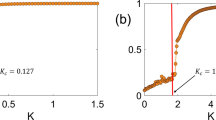Abstract
We explore the behavior of groups of Landau-Stuart oscillators, with diffusive mean-field coupling within the group and indirect inter-group coupling mediated by a common medium. Interestingly, we find that oscillations are revived in groups with fixed point dynamics by coupling to an oscillatory group through the common medium. We also investigate groups of Hindmarsh–Rose model neurons and demonstrate the emergence of spiking in indirectly coupled inactive neuronal groups, indicating the vital role of the common medium in restoring oscillations.





Similar content being viewed by others
References
Sharma, A., Shrimali, M.D.: Amplitude death with mean-field diffusion. Phys. Rev. E 85, 057204 (2012)
Prasad, A., Dhamala, M., Adhikari, B.M., Ramaswamy, R.: Amplitude death in nonlinear oscillators with nonlinear coupling. Phys. Rev. E 81, 027201 (2010)
Banerjee, T., Ghosh, D.: Transition from amplitude to oscillation death under mean-field diffusive coupling. Phys. Rev. E 89, 052912 (2014)
Kamal, N.K., Sharma, P.R., Shrimali, M.D.: Oscillation suppression in indirectly coupled limit cycle oscillators. Phys. Rev. E 92, 022928 (2015)
Sharma, A., Sharma, P.R., Shrimali, M.D.: Amplitude death in nonlinear oscillators with indirect coupling. Phys. Lett. A 376, 1562 (2012)
Karnatak, R., Ramaswamy, R., Feudel, U.: Conjugate coupling in ecosystems: cross-predation stabilizes food webs. Chaos Solitons Fractals 68, 48 (2014)
Kiss, I.Z., Hudson, J.L.: Phase synchronization and suppression of chaos through intermittency in forcing of an electrochemical oscillator. Phys. Rev. E 64, 046215 (2001)
Ermentrout, G.B., Kopell, N.: Oscillator death in systems of coupled neural oscillators. SIAM J. Appl. Math. 50, 125 (1990)
Gallego, B., Cessi, P.: Decadal variability of two oceans and an atmosphere. J. Clim. 14, 2815 (2001)
Prasad, A.: Amplitude death in coupled chaotic oscillators. Phys. Rev. E 72, 056204 (2005)
Zou, W., Senthilkumar, D., Nagao, R., Kiss, I.Z., Tang, Y., Koseska, A., Duan, J., Kurths, J.: Restoration of rhythmicity in diffusively coupled dynamical networks. Nat. Commun. 6, 7709 (2015)
Zou, W., Senthilkumar, D., Zhan, M., Kurths, J.: Reviving oscillations in coupled nonlinear oscillators. Phys. Rev. Lett. 111, 014101 (2013)
Ghosh, D., Banerjee, T., Kurths, J.: Revival of oscillation from mean-field-induced death: theory and experiment. Phys. Rev. E 92, 052908 (2015)
Zou, W., Yao, C., Zhan, M.: Eliminating delay-induced oscillation death by gradient coupling. Phys. Rev. E 82, 056203 (2010)
Kar, S., Ray, D.S.: Collapse and revival of glycolytic oscillation. Phys. Rev. Lett. 90, 238102 (2003)
Cao, H., Huang, R.K., Yamamoto, Y., Jiang, S., Machida, S., Takiguchi, Y.: Collapse and revival of the oscillation of microcavity emission and its phase spectrum. Phys. Stat. Solidi 164, 29 (1997)
Sneyd, J., Tsaneva-Atanasova, K., Yule, D.I., Thompson, J.L., Shuttleworthi, T.J.: Control of calcium oscillations by membrane fluxes. Proc. Natl. Acad. Sci. USA 101, 1392 (2004)
Brgers, C., Epstein, S., Kopell, N.J.: Gamma oscillations mediate stimulus competition and attentional selection in a cortical network model. Proc. Natl. Acad. Sci. USA 105, 18023 (2008)
Sawai, S., Maeda, Y., Sawada, Y.: Spontaneous symmetry breaking turing-type pattern formation in a confined Dictyostelium cell mass. Phys. Rev. Lett. 85, 2212–2215 (2000)
Toth, R., Taylor, A.F., Tinsley, M.R.: Collective behavior of a population of chemically coupled oscillators. J. Phys. Chem. B 110, 10170–10176 (2006)
Kondo, S., Miura, T.: Reaction–diffusion model as a framework for understanding biological pattern formation. Science 329, 1616–1620 (2010)
Richard, P., Bakker, B.M., Teusink, B., Dam, K.V., Westerhoff, H.V.: Acetaldehyde mediates the synchronization of sustained glycolytic oscillations in populations of yeast cells. Eur. J. Biochem. 235, 238 (1996)
Shockley, K., Butwill, M., Zbilut Jr., J.P., Webber, C.L.: Cross recurrence quantification of coupled oscillators. Phys. Lett. A 305, 59 (2002)
Resmi, V., Ambika, G., Amritkar, R.E.: Synchronized states in chaotic systems coupled indirectly through a dynamic environment. Phys. Rev. E 81, 046216 (2010)
Majhi, S., Bera, B.K., Bhowmick, S.K., Ghosh, D.: Restoration of oscillation in network of oscillators in presence of direct and indirect interactions. Phys. Lett. A 380, 3617 (2016)
Hindmarsh, J.L., Rose, R.M.: A model of neuronal bursting using three coupled first order differential equations. Proc. R. Soc. Lond. Ser. B 221, 87 (1984)
Mamat, M., Kueniawan, P.W., Kartono, A., Salleh, Z.: Mathematical model of dynamics and synchronization of coupled neurons using Hindmarsh–Rose model. Appl. Math. Sci. 6, 2489 (2012)
Checco, P., Biey, M., Righero, M., Kocarev, L.: Synchronization and bifurcations in networks of coupled Hindmarsh–Rose neurons. In: IEEE International Symposium on Circuits and Systems, New Orleans, LA, pp. 1541–1544 (2007)
Perin, R., Berger, T.K., Markram, H.: A synaptic organizing principle for cortical neuronal groups. Proc. Natl. Acad. Sci. USA 108, 5419 (2011)
Litwin-Kumar, A., Doiron, B.: Slow dynamics and high variability in balanced cortical networks with clustered connections. Nat. Neurosci. 15, 1498 (2012)
Rosenblum, M., Pikovsky, A.: Synchronization: from pendulum clocks to chaotic lasers and chemical oscillators. Contemp. Phys. 44, 401–416 (2003)
Banghart, M., Borges, K., Isacoff, E., Trauner, D., Kramer, R.H.: Light-activated ion channels for remote control of neuronal firing. Nat. Neurosci. 7, 1381 (2004)
Steinlein, O.K., Noebels, J.L.: Ion channels and epilepsy in man and mouse. Curr. Opin. Genet. Dev. 10, 286 (2000)
Kagana, B.L., Hirakura, Y., Azimov, R., Azimova, R., Lin, M.C.: The channel hypothesis of Alzheimer’s disease: current status. Pepetides 23, 1311 (2002)
Ozer, M., Perc, M., Uzuntarla, M.: Controlling the spontaneous spiking regularity via channel blocking on Newman-Watts networks of Hodgkin–Huxley neurons. Europhys. Lett. 86, 40008 (2009)
Acknowledgements
We acknowledge the support from DST, New Delhi.
Author information
Authors and Affiliations
Corresponding author
Rights and permissions
About this article
Cite this article
Yadav, M., Sharma, A., Shrimali, M.D. et al. Revival of oscillations via common environment. Nonlinear Dyn 91, 2219–2225 (2018). https://doi.org/10.1007/s11071-017-4010-3
Received:
Accepted:
Published:
Issue Date:
DOI: https://doi.org/10.1007/s11071-017-4010-3




